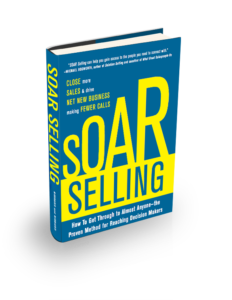David and Marhnelle Hibbard have just released Soar Selling, a new book designed for anyone in sales. And, in my opinion, all of us are in sales and can benefit from learning the techniques in books like this one. The subtitle is, “How to Get Through to Almost Anyone-the Proven Method for Reaching Decision Makers,” but it’s more comprehensive than that subtitle suggests. It’s a must read for anyone in the world of selling.
I recently had the opportunity to ask David and Marhnelle about SOAR and their observations of the world of selling.
First, what does the SOAR acronym stand for? 
It stands for “Surge of Accelerating Revenue” because when organizations install SOAR… revenue ‘surges!’ – It’s about driving net new business. Through years of training sales, we have seen client attrition in organizations, mergers, economic shifts, loss of major accounts, etc….as a result, it is critical to consistently drive new business to protect base revenue! So SOAR is about driving strategic call activity to potential new clients.
As your subtitle suggests, you have methods for getting to decision makers in this book. It’s impossible in a quick interview to delve into all of the tactics and methods for doing that, so we will briefly touch on that and then hit other areas. What have you observed is the biggest problem for sales people reaching decision makers?
Multiple, but one of the primary is their “mindset.” Salespeople often approach making the call with an attitude of “TRY” or even worse…“I don’t think I’ll get through – I’ll probably get blocked or the receptionist is out to get me.”
Mindset and attitude figure prominently in your teaching. Tell us more about mindset.
“If you think you can or your think you can’t …either way you are right.” We teach the techniques of getting through and there is a specific formula SOAR reveals; however, the power of mindset and strategic SOAR mechanics ends up defining results!
One of the things I liked about this book is that you have so many examples of where something was successful and where it failed. Would you share an example of watching how a poor mindset affected an outcome?
YES, recalling one class before we began to make live calls in class, we “grounded” the fact that we could and WOULD make contact 100% of the time when making the calls – and we DID! Everyone was ecstatic about the results; it was very revealing to see the power of MINDSET demonstrated.
Let’s touch on “keyword listening.” Give a few common words and tell me how Soar Selling students would hear them versus others.
Receptionists often say…”I don’t believe he is in”…..the key word is Believe…so we challenge that word, or when the receptionist say’s…”I haven’t seen him today”….doesn’t’ mean he isn’t in…so we challenge that statement….or if the receptionist says…”he isn’t available”….doesn’t mean he isn’t available….we end up challenging the word interpretation ‘available’….does that mean he is out?, he is in a meeting?, the receptionist hasn’t’ seen him yet?….what??? If a man asks his wife…..“Honey, am I still the stud you married” and his wife responds “for the most part”….we’re sure the husband hears the key word or phrase ‘for the most part’. Conversely when a client says, “We are pretty happy with our current provider,” it often slips right past the listener. It’s interesting how salespeople don’t hear opportunities during prospecting calls!
I’ve written about how, as a CEO, I love to occasionally answer my phone and surprise a salesperson who didn’t expect me to answer. I’m amazed at what happens. There are times when the person doesn’t know what to say. I had one guy hang up. Talk about the critical value statement and how important it is to the sales process.
 It’s comical – you are absolutely right – again it goes back to mindset – most people DONT THINK THEY WILL REACH THE DECISION MAKER so when it happens they FREEZE!! We practice what to say before making contact! The more salespeople format their value statement and use SOAR the better they are at delivering a compelling value statement.
It’s comical – you are absolutely right – again it goes back to mindset – most people DONT THINK THEY WILL REACH THE DECISION MAKER so when it happens they FREEZE!! We practice what to say before making contact! The more salespeople format their value statement and use SOAR the better they are at delivering a compelling value statement.
In one of the sections, you talk about the DISC system for understanding your clients. I will point people to that chapter, but give us an example of the DISC in action. How do you properly use a tool like this in sales?
This is a critical piece of information especially when calling in to someone a salesperson doesn’t really know. Behavior is very transparent and when a salesperson is keenly aware of the different styles and what each style of behavior means, then they can make an instant connection. For example, I am a high “D” (dominate) so I appreciate someone getting to the point and giving me choices. Bottom-line & big picture works for me. If a caller started by saying “Hi, I am Bob how are you today?” I honestly think ….I don’t have time for this what do you want? So the polite, nice approach actually irritates me! Being able to quickly connect with who a salesperson is speaking to is a key element that supports a positive outcome.
As someone who came up through sales organizations, I loved your concept of dealing with the “send me something” request. I could have used this chapter years ago. Tell me more about it and how to properly handle this request.
Delicately, suggesting to drop off something at the ‘reception desk’ is not a threat to the person the salesperson is speaking to – no threat that you are coming to see them. Then shifting to the technique of ‘call from the lobby to put a face to a voice’ can literally generate a fixed appointment! It is a very sophisticated approach to making contact and it takes finesse.
You’ve trained sales people in companies of all sizes. Are there characteristics good sales people share? Can anyone learn to be successful or are some people cut out for other fields?
First of all, we have discovered that it’s not always ‘aptitude’ or raw talent. Generally we have found that it’s about attitude or as we call it ‘mindset.’ The key characteristics are:
1. Mechanics (How you do it)
2. Vision (Why you do it)
3. History (What beliefs may be holding back success)
4. Coach (Someone who can provide intelligent guidance)

